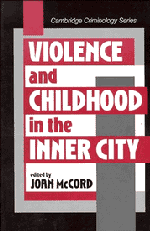Book contents
- Frontmatter
- Contents
- List of Contributors
- Preface
- 1 Violence and the Inner-City Street Code
- 2 The Embeddedness of Child and Adolescent Development
- 3 Placing American Urban Violence in Context
- 4 Neuropsychology, Antisocial Behavior, and Neighborhood Context
- 5 Psychological Mediators of Violence in Urban Youth
- 6 Understanding and Preventing Child Abuse in Urban Settings
- 7 Intervening to Prevent Childhood Aggression in the Inner City
- Name Index
- Subject Index
5 - Psychological Mediators of Violence in Urban Youth
Published online by Cambridge University Press: 01 June 2011
- Frontmatter
- Contents
- List of Contributors
- Preface
- 1 Violence and the Inner-City Street Code
- 2 The Embeddedness of Child and Adolescent Development
- 3 Placing American Urban Violence in Context
- 4 Neuropsychology, Antisocial Behavior, and Neighborhood Context
- 5 Psychological Mediators of Violence in Urban Youth
- 6 Understanding and Preventing Child Abuse in Urban Settings
- 7 Intervening to Prevent Childhood Aggression in the Inner City
- Name Index
- Subject Index
Summary
A single mother who grew up and currently lived in a working class urban community proudly told her pediatrician the following story of how she taught her child to deal with violence (Stringham, 1993, personal communication):
When her 5 year old daughter complained that another girl had been hitting her on the way home from school, the mother told her to hit the other girl back. The daughter replied, “No, Mom, I can't. She's bigger than me and I'm afraid of her.” The mother had grown up in an urban housing project where as a child she had experienced a great deal of violence as a witness, a victim, and a perpetrator. Drawing from her childhood experience, she decided to teach her daughter a lesson in dealing with violence. So she walked her outside, locked the door, and told her through the screen door, “You won't get back into this house until you come back with the other girl's two front teeth.”
More than an hour later, her daughter came back, knocking on the door softly and crying. She didn't know if her mother would let her back into the house because she had only one-half of a tooth from the other girl to present to her mother. She had broken it off with a rock. The mother agreed to let her daughter back into the house. […]
- Type
- Chapter
- Information
- Violence and Childhood in the Inner City , pp. 171 - 206Publisher: Cambridge University PressPrint publication year: 1997
- 6
- Cited by



